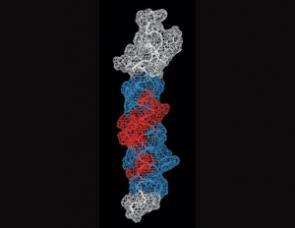Nuclear Magnetic Resonance observes inhibitors bound to enzymes

A team of researchers led by Professor Paul Malthouse, principal investigator with the Centre for Synthesis and Chemical Biology and UCD Conway Institute, uses state-of-the-art NMR equipment to study a range of biological processes. Insights gained could help in the design of drugs for an array of medical conditions.
Long established as a powerful tool for determining the structure of small molecules, nuclear magnetic resonance (NMR) spectroscopy is now unravelling the secrets of previously inaccessible biological macromolecules, thanks to recent advances in the field. Bigger and more powerful spectrometers with higher magnetic field strengths offer new insights into the reactions happening in our bodies.
Enzymes, like other proteins, were traditionally characterised in the solid state by X-ray crystallography. NMR has a significant advantage as biomolecules can now be studied in their natural environment in bodily fluids and even in cell membranes using solid state NMR.
Inihibited enzymes
Protein-digesting enzymes called proteases play a role in propagating the AIDS virus, in allowing cancers and parasites to move through tissues and in the production of the plaque protein which causes Alzheimer’s disease.
Inhibiting these enzymes is key to treating such diseases. Drugs are designed to target enzymes by slotting into their active sites and shutting them down. Drug design seeks to optimise inhibitor binding, so we need to understand how the inhibitors interact with an enzyme.
"We are synthesising protease inhibitors and using NMR to determine how they interact with specific proteases. By studying these interactions we hope to see ways of optimising an inhibitor’s ability to inhibit the specific protease involved in a given disease,” explains Professor Malthouse.
Designing drugs
It is essential that potent protease inhibitors designed will only target the protease involved in the disease and not those which are essential for our bodies.
"We are currently starting to synthesise and characterise a range of inhibitors which we hope will provide important insights into the development of drugs to treat a range of medical conditions,” continues Professor Malthouse.
New targets for treatment of diabetes and obesity
A group including Professor Malthouse and Dr Chandralal Hewage, NMR scientist at the NMR Centre in UCD Conway Institute, have exploited NMR technology to solve the 3D solution structure of the gastrointestinal polypeptide GIP.
GIP is a hormone that stimulates the secretion of insulin after ingestion of food and has been linked to diabetes and obesity-related diseases.
A 3D picture of the protein was built step by step using a range of NMR experiments and molecular modelling calculations. Two-dimensional NMR spectra revealed information about the connectivities of the atoms, allowing the identity of each amino acid residue to be determined.
Dr Hewage explains the significance of these studies: “Understanding the structural requirements for the biological activity of GIP will help in the design of new drugs for diabetes and obesity related disorders.”
"Proteins are huge molecules but commercially viable drugs need to be a lot smaller both for ease of entry into cells and because of the manufacturing costs involved. Once the structure of the protein is known, the important residues can be identified and a smaller drug molecule synthesised.”
Citation:
Djurdjevic-Pahl, A.; Hewage, C.; Malthouse, J. P. G., Biochimica et Biophysica Acta (BBA) - Proteins & Proteomics, 2005, 1749, 33.
Alana, I; Parker, J. C.; Gault, V. A; Flatt, P. R.; O'Harte, F. P. M.; Malthouse, J. P. G.; Hewage, C. M., J. Biol. Chem. 2006, 281 (24), 16370.
Source: Centre for Synthesis and Chemical Biology















